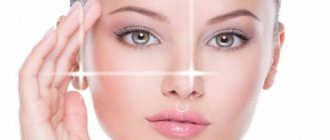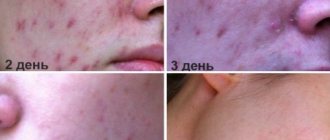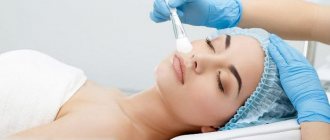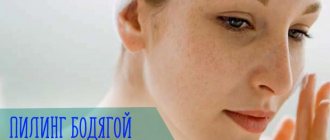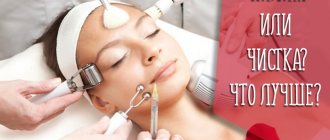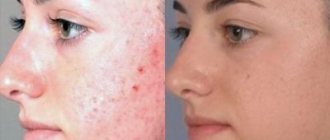Properties of glycolic acid
Hydroxyacetic acid is of plant origin, it is obtained from sugar cane, beets or grapes. The small size of molecules and low molecular weight allow the exfoliant to quickly and deeply penetrate the integument, right down to the dermis. These properties are responsible for the pronounced effect after the procedure.
Glycolic acid acts simultaneously in several directions:
- cleanses - the molecules of the substance destroy the connections between keratinized cells and promote their removal. As a result, the skin becomes softer, the relief is smoothed;
- rejuvenates - the drug activates the natural regeneration mechanism of the skin, increases the firmness and elasticity of the fibers;
- has an anti-inflammatory effect, so glycolic cleansing is often used to prevent acne;
- moisturizes, thanks to the ability of hydroxyacetic molecules to retain moisture particles;
- increases the protective properties of the skin;
- whitens the skin by removing accumulations of melanin.
Hydroxyacetic acid is considered one of the favorite fruit acids of cosmetologists and clients of beauty salons. The gentleness of the impact along with the pronounced effect are the main advantages of the procedure.
Where can I buy
Glycolic facial peeling does not require long-term rehabilitation; the process of restoring the integrity of the skin proceeds calmly, without complications or allergic reactions. Therefore, girls often resort to cleansing procedures at home.
For home cleansing, you need to purchase special kits containing glycolic acid. They are sold in pharmacies and specialized professional cosmetics stores. It is not recommended to buy acid peeling products on the Internet, unless these are the official websites of the product manufacturer.
The professional glycolic peeling kit includes:
- a scrub based on fruit acids or another product for pre-peeling cleansing and skin preparation;
- gel peeling with a concentration of glycolic acid of 15–50%;
- acid neutralizer.
Such sets may additionally include soothing and moisturizing masks, makeup remover, application brush, day and night care creams. Accordingly, the cost of such a kit increases.
Attention! Cosmetologists strongly do not recommend performing acid treatments on your own. Acid with a concentration of 10% corrodes rust, imagine what can happen to the skin if the chemical is used inappropriately.
Compatible with other procedures
Glycolic peeling is compatible with a number of cosmetic procedures that complement each other and enhance the effect. The ideal option would be hydration - mesotherapy, hardware introduction of moisturizers. There is a procedure combining glycolic peeling and mesotherapy called mesopil.
Moisturizing is necessary when recovering from glycolic peeling, and to achieve the best result, you need to use moisturizing masks and care products.
Glycolic peeling is also compatible with ultrasonic peeling. As a result, the best effect from both procedures is achieved. One of the latest innovations in cosmetology is hardware glycolic peeling with ultrasound.
The essence of peeling
Glycolic acid in terms of application technology is no different from lactic, pyruvic and other fruit acids. The concentrated exfoliant is distributed over the surface of the face, neutralized after a while and washed off.
Acid molecules, acting on the upper layers of the skin, help remove accumulated dead cells, stimulate tissue regeneration, smooth out the relief and tone of the face. Such changes in combination provide a pronounced rejuvenating effect and improve the quality of the integument.
The higher the acid concentration in the exfoliant, the deeper the effect and the more pronounced the result. There are superficial and medium glycolic peels.
Superficial glycolic peeling involves targeting the upper layers of the skin. The acid concentration is 5–40%. The procedure is indicated for young skin with minor age-related defects.
Medium peeling provides a deep and aggressive effect on the skin, right down to the basement membrane. To carry it out, cosmetologists use formulations with 45–80% glycolic acid. Designed for aging, mature skin. The recovery period lasts up to 1 month.
In beauty salons, clients most often do 50% glycolic peeling. For a home procedure, a content of 15% glycolic acid is sufficient; an increased concentration can be dangerous and lead to complications in the absence of appropriate experience and professional skills.
Medium glycolic peeling 30, 40, 50%
An acid concentration of up to 50% in the procedure is a medium peeling. It has a deeper effect on the epidermis. The method is used for:
- removal of stretch marks;
- eliminate acne;
- removal of facial wrinkles.
Medium peeling shows significant results. The composition penetrates deeper into the skin. The disadvantage is a longer recovery. After the procedure, skin peeling, swelling, and pain may appear for 30 to 60 minutes.
Recovery occurs within 7 days, but skin redness lasts about 6 weeks.
Don’t miss the most popular article in the section: Plasmolifting of the face - what it is, how it is carried out, results, photos before and after the procedure.
Indications for use
Indications for exfoliation may include:
- wrinkles on the face, no matter facial or age-related;
- loss of firmness and elasticity of the integument;
- hyperpigmentation, photoaging of the skin;
- hyperkeratosis;
- superficial scars, stretch marks (stretch marks) on the face;
- post-acne, including tissue compaction at the site of inflammation, age spots, uneven skin texture;
- increased fat content, greasiness of the integument;
- enlarged pores;
- seborrhea, peeling skin;
- molluscum contagiosum;
- acne, acne without tissue inflammation.
Cosmetologists can recommend using the procedure to patients who decide to undergo facial plastic surgery before deep peeling or laser skin resurfacing.
Acid cleaning is recommended for clients over 18 years of age. In some cases, after a medical examination and analysis of the skin problem, it is allowed to be performed on younger patients.
Exfoliation efficiency
Facial peeling with glycolic acid cannot guarantee significant skin rejuvenation and smoothing of all age-related wrinkles and deep scars. For this, cosmetology offers more complex anti-aging procedures, such as laser resurfacing, deep peeling, and plastic surgery.
After a course of exfoliation with hydroxyacetic acid, you should expect the following changes:
- the complexion is evened out and improved;
- the skin texture becomes smoother and smoother;
- the elasticity of the fibers increases;
- acne on the face decreases, the skin becomes clean and looks healthy;
- pores become narrower, the greasiness of the integument decreases.
Cleansing with glycolic acid can improve the quality of the skin in all directions, and for more mature clients it can delay aging and rejuvenate the appearance.
Important point! To achieve a pronounced effect, one procedure is not enough. Cleansing is carried out in courses.
The duration of therapy depends on several factors, including the client’s age, sensitivity of the integument, and their primary condition. The course of superficial cleansing involves 3–10 sessions with an interval of 7–10 days. To refresh young skin and improve its color, 2-3 sessions are enough. Medium peels should be done once every 3 months. The number of procedures is determined only by the cosmetologist.
Operating principle
Glycolic acid has other traditional names - hydroxyacetic acid and hydroxyethanoic acid. It belongs to the class of alpha hydroxy acids (AHAs), which are used for superficial and medium exfoliation (very rarely).
Glycolic peeling is suitable for all skin types. The main thing is to prepare for it correctly, to choose the appropriate concentration of hydroxyethanoic acid.
Before the course of exfoliation, you need to prepare the epidermis for two weeks, loosening it with nightly use products with a concentration of the main active ingredient of 3-5%.
Then the main procedure is carried out in the salon or at home with an initial concentration of up to 20%, repeating it every ten days 6-8 times.
After two months, the glycolic peel is repeated with a higher concentration to achieve results.
The advantages of such exfoliation:
- suitable for all types;
- effectively rejuvenates at the cellular level, activating the formation of collagen fibers, prevents aging;
- stimulates breathing and metabolic processes of the skin, enriching it with oxygen;
- evens out the relief, tightening pores and removing unevenness;
- polishes the skin after plastic surgery;
- eliminates age spots, whitens;
- inhibits the activity of bacteria that cause acne.
A relative disadvantage of the procedure is its gradual nature. Glycolic peeling does not give you great results right away.
The impatient, deceived by the gentleness of the effect, risk getting light chemical burns on the unprepared epidermis.
But by showing patience and endurance, you can make your face look young, rested, with an even texture and beautiful color.
Preparatory stage
Acid exposure is performed on prepared skin. Pre-peeling preparation is an important stage of the procedure, which reduces the risk of side effects and shortens the recovery period.
7–10 days before the intended procedure, you should visit a cosmetologist and do a skin sensitivity test to the drug used. If the client does not observe visible allergic manifestations within 24 hours, the product can be used.
During the week before acid cleansing, it is important to use a cream containing glycolic acid. There is no need to apply this cream on the day of cleaning. As a preventive measure, a cosmetologist can prescribe antiherpetic drugs to prevent the appearance of herpes during rehabilitation.
Note! It is highly undesirable to carry out glycolic peeling in the summer. High solar activity can cause skin pigmentation.
Is it possible to do a chemical glycolic peel during pregnancy?
During pregnancy, the body reacts strongly to changes in hormonal balance. Problems worsen.
- Once in the bloodstream, chemical components harm the embryo.
- Peeling enhances pigmentation from exposure to sunlight.
- Without knowing how the body will react during a procedure such as glycolic peeling, or what the consequences will be, a woman puts herself at risk. The skin of a pregnant woman is sensitive to irritants.
- The products have a pungent odor that is unpleasant for the expectant mother. During this period, it is better to use less aggressive methods of facial cleansing, leaving the peeling procedure until the end of lactation.
Main stages of the procedure
Facial peeling with glycolic acid in a beauty salon and at home is performed in a strictly defined sequence:
- The skin is cleansed of makeup residues using lotion. This stage also allows you to get rid of fat particles that prevent the penetration of acid molecules into the skin.
- To loosen the stratum corneum, low concentration glycolic acid (up to 5%) is applied to the face. This technique allows you to increase the effectiveness of the product, improve its penetration, and prepare cells for exfoliation.
- Then the main peeling agent of the selected concentration is applied. There is no anesthesia, you may feel a slight burning or tingling sensation. A stream of air directed at the face will help relieve such symptoms. To do this, use a fan or fan.
- For beginners, the recommended acid exposure time is 1 minute. For further sessions, the time should be increased by 1–2 minutes. In addition, you can apply several layers of exfoliant. The more there are, the stronger the impact and the higher the effectiveness of the procedure. But keep in mind that at the same time the burning and tingling intensifies. The duration of exposure can be 5–30 minutes, depending on the concentration of the acid, the desired effect, sensitivity and skin problems.
- A weak alkaline solution or neutralizer will help neutralize the effect of the acid; it comes in the peeling kit. Apply it evenly to the skin and rinse thoroughly with warm water. Under no circumstances should you wash off the acidic product with water immediately, as burns may occur.
- To soothe the skin after acid exposure and restore the water-alkaline balance, use a moisturizing face mask and nourishing cream with SPF 30 or more.
Important point! Peeling with glycolic acid takes 20–40 minutes. Cosmetologists recommend performing the first session with a specialist. In the future, the procedure is possible at home, according to the recommendations of a cosmetologist.
Observe the following precautions during the procedure:
- a test for an allergic reaction is required, it is carried out 7–10 days before peeling;
- any malaise or poor health is a reason to postpone the procedure;
- use disposable gloves on your hands when working with the selected product;
- apply the exfoliant gel with a brush or cotton swab, excluding sensitive areas around the eyes;
- be extremely careful and careful not to get the product into your eyes;
- strong burning during cleansing is unacceptable; the exfoliant should be immediately neutralized and washed off. The reason for this may be an incorrectly selected acid concentration;
- After the procedure, wash your hands with soap.
Consequences
Despite the fact that peeling with glycolic acid is one of the safest procedures, the possibility of complications after it cannot be ruled out. Among the most common are the following.
Hyperpigmentation
This is a sign that the skin has increased photosensitivity. This side effect may occur as a result of non-compliance with the rules during the recovery period.
Before deciding to use this technique, it is important to pay attention to the existing contraindications and follow the advice of a cosmetologist. This will prevent the appearance of age spots on the skin of the face.
Burn
Often patients receive the first or second degree, which may be as a result of an excessive acid consistency or in situations where the exposure time of the drug increases. At the first suspicion of a complication of this kind, the acid must be immediately neutralized and the epidermis treated with an anti-burn agent.
Performing other exfoliating procedures is allowed only after the skin has completely recovered.
Allergy
As a rule, it is a consequence of violation of the rules for performing cosmetic manipulation. Before using acid, be sure to do a test test. If severe swelling, redness, or itching occurs, the procedure is postponed. If breathing difficulties occur, immediate medical attention is required.
Dry skin
If such a reaction occurs after chemical peeling, you need to visit your cosmetologist again. He will assess the condition of the epidermis and select additional care products.
Healing period
After peeling, the face will be red, you will feel dryness, tightness, and possible swelling. These symptoms will last from several hours to several days, depending on the individual characteristics of the integument. Despite the naturalness of the acid and the mildness of its effect, after glycolic peeling the skin needs special care. The duration of recovery largely depends on the depth of tissue damage, their sensitivity to the drug, and the age of the user.
During the rehabilitation period:
- it is important to use cosmetics without aggressive chemical additives or surfactants;
- After washing, blot the remaining moisture with a clean towel or paper napkins. You can't rub;
- Apply sunscreen to your face every day to avoid skin hyperpigmentation;
- try to limit your time outside;
- to accelerate fiber regeneration, use moisturizing cosmetics and wound-healing gels, like Panthenol. Which products are better, check with your cosmetologist;
- it is possible to take antihistamines and antiviral drugs (also as prescribed by a specialist);
- no scrubs or rubbing - peeling will go away on its own;
- visiting solariums, baths, saunas, swimming pools is prohibited;
- Until the skin is completely restored, decorative cosmetics should be abandoned.
After 5–7 days, the first changes are noticeable, the skin becomes softer and more tender, and a healthy glow appears. It is recommended to finally evaluate the effect after a course of peelings.
Precautionary measures
The absence of contraindications is one of the main conditions for performing the procedure. Neglecting them will affect the condition of the skin, can lead to complications and will only worsen health problems. Reasons for refusing to use a glycolic agent may include:
- rosacea, rosacea on the face;
- fresh tan;
- allergy to acid or auxiliary components of the selected product;
- skin inflammation, dermatitis, herpes;
- wounds, scratches and other violations of the integrity of the integument on the face;
- pregnancy;
- lactation;
- papillomas, moles, warts in the treatment area;
- oncology, diabetes mellitus;
- rehabilitation after chemotherapy.
It is not recommended for those with dry or combination skin types to cleanse themselves; trust the professionals. Incorrectly selected peeling concentration and exposure time will significantly worsen the current condition of the skin.
Attention! It is highly undesirable to do glycolic peeling in the summer. The optimal season for the procedure is winter, early spring or late autumn.
Sometimes, even in the absence of contraindications, home cleansing ends in complications. The reason for this is a violation of the sequence of actions, exceeding the concentration of the product and errors in further care.
Frequent complications, side effects and causes of their occurrence:
- prolonged hyperemia, burns, peeling, appearance of crusts - the acid concentration is chosen incorrectly, violation of the peeling technique;
- rashes, itching of an allergic nature - an allergy test was not performed;
- the appearance of age spots - the skin was not protected from sunlight or peeling was carried out in the summer, during a period of high solar activity;
- herpes - neglect to take antiviral drugs before and after peeling.
Any complication is a reason to consult a specialist. Only a doctor will prescribe proper treatment and organize proper care.
Contraindications
Like any other cosmetic procedure, glycolic peeling has contraindications. It cannot be carried out:
- during pregnancy and lactation;
- for serious diseases of the cardiovascular system, asthma or diabetes;
- if there are wounds, cuts, inflammations on the skin;
- with herpes (during an exacerbation) or rosacea;
- if there are neoplasms or warts on the skin;
- within a few days after hair removal or sunbathing;
- with excessive photosensitivity of the skin;
- if you are allergic to glycolic acid or other ingredients used for peeling.
Advantages and disadvantages
Chemical peeling is a popular type of cosmetic procedure for cleansing and rejuvenating the skin. A pronounced effect and an affordable price are its main advantages.
Among the advantages of glycolic peeling it is also worth highlighting:
- soft and deep cleansing;
- versatility - suitable for dry, combination, oily, problem skin at any age;
- does not require anesthesia;
- characterized by an easy course of rehabilitation, rarely accompanied by complications;
- can be performed at home.
There are also disadvantages:
- restoration of the integument will take some time, special care will be required;
- ineffective against deep wrinkles, tissue ptosis;
- a single procedure will not provide the desired, long-term result; a course of peelings will be required;
- there is a risk of complications if exfoliation is performed incorrectly;
- has contraindications.
The benefits and harms of chemical glycolic peeling
Not knowing about glycolic peeling and what it is, many clients think that the method is indicated for mature women to get rid of wrinkles. But peeling has a wide range of services. Acid accelerates metabolic processes.
The procedure promotes healthy skin. It becomes elastic, cells are renewed.
However, the method has disadvantages. There is pain, long healing, and possible complications. If you apply the procedure correctly, there will be no difficulties.
Opinion of cosmetologists
Cosmetologists recommend doing glycolic peeling as an independent or auxiliary procedure (before plastic surgery, deep skin resurfacing).
Please note that cosmetologists insist on professional peeling, because home care cannot guarantee a decent result.
The effectiveness of cleansing is influenced by many factors, including acidity. Here's what experts say about it.
In the following review, the cosmetologist recommends to novice cosmetologists and lovers of home transformations which peelings are best to use in their work.
Video
- Video of a glycolic peeling session in the salon with a full description of the procedure and its stages.
- Glycolic peeling at home using Belita Vitex products.
- Master class on glycolic peeling from a professional cosmetologist.
- Mary Kay glycolic peeling, description of the product, method of its use, results.
Glycolic peeling is a great way to restore your skin's freshness and healthy appearance without much effort or waste. Have you tried this procedure? Do you do it yourself or visit a salon? Share with us your impressions and thoughts about this peeling.
Patient reviews
Patients really like glycolic peeling; they note a decent effect and an affordable price, a gentle effect and an easy rehabilitation period.
The peeling result primarily depends on the acid concentration (percentage). You can use it to rejuvenate your skin or get rid of blackheads, as the following user does:
In the following review, the girl is pleased with the changes on her face, but considers the cost of the procedure to be overpriced.
Peeling cannot be done with rosacea or rosacea on the face. Summer is not the season for glycolic acid. Cleaning features are specified by the next user.
It is difficult to find negative reviews about the procedure. To a greater extent, dissatisfaction is caused by the poor quality of the drug or violation of the technology of cleansing, improper care of the face before and after it.
Acid peeling is an effective and proven way to deeply cleanse, refresh and rejuvenate your appearance. But do not forget that it should be carried out by a professional. By performing the procedure at home, you increase the risk of complications and side effects.
Where can I do this procedure?
If you are interested in the glycolic acid peeling procedure, we will be happy to share with you the contacts of salons and clinics where it can be done.
Glycolic peeling in Moscow
- Clinic of Innovative Medical Technologies “Vector”: st. Krupskaya, 19/17, tel.
Glycolic peeling in St. Petersburg.
- Medical: st. Marata, 2, tel.
Glycolic peeling in Kyiv
- Clinic of intensive cosmetology “Edit”: per. Bekhterevsky, 8, tel: +38.

